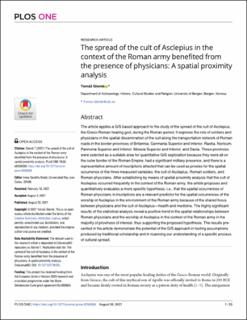| dc.description.abstract | The article applies a GIS based approach to the study of the spread of the cult of Asclepius, the Greco-Roman healing god, during the Roman period. It explores the role of soldiers and physicians in the spatial dissemination of the cult along the transportation network of Roman roads in the border provinces of Britannia, Germania Superior and Inferior, Raetia, Noricum, Pannonia Superior and Inferior, Moesia Superior and Inferior, and Dacia. These provinces were selected as a suitable area for quantitative GIS exploration because they were all on the outer border of the Roman Empire, had a significant military presence, and there is a representative amount of inscriptions attested that can be used as proxies for the spatial occurrence of the three measured variables: the cult of Asclepius, Roman soldiers, and Roman physicians. After establishing by means of spatial proximity analysis that the cult of Asclepius occurred frequently in the context of the Roman army, the article proposes and quantitatively evaluates a more specific hypothesis; i.e., that the spatial occurrences of Roman physicians in inscriptions are a relevant predictor for the spatial occurrences of the worship of Asclepius in the environment of the Roman army because of the shared focus between physicians and the cult of Asclepius—health and medicine. The highly significant results of the statistical analysis reveal a positive trend in the spatial relationships between Roman physicians and the worship of Asclepius in the context of the Roman army in the majority of provinces of interest, thus supporting the proposed hypothesis. The results presented in the article demonstrate the potential of the GIS approach in testing assumptions produced by traditional scholarship and in nuancing our understanding of a specific process of cultural spread. | en_US |

